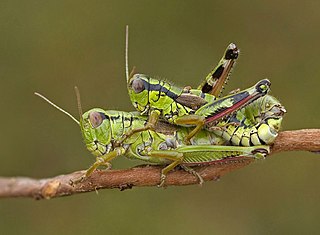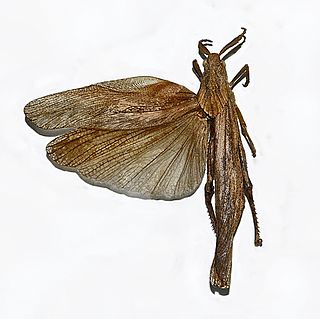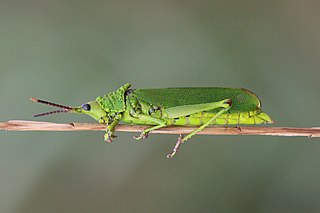
Bandwings, or band-winged grasshoppers, are the subfamily Oedipodinae of grasshoppers classified under the family Acrididae. They have a worldwide distribution and were originally elevated to full family status as the Oedipodidae. Many species primarily inhabit xeric weedy fields, and some are considered to be important locusts:

Tetrigidae is an ancient family in the order Orthoptera, which also includes similar families such as crickets, grasshoppers, and their allies. Species within the Tetrigidae are variously called groundhoppers, pygmy grasshoppers, pygmy devils or "grouse locusts".

Acridoidea is the largest superfamily of grasshoppers in the order Orthoptera with species found on every continent except Antarctica.

Pyrgomorphidae is a family of grasshoppers in the order Orthoptera; it is the only family in the superfamily Pyrgomorphoidea, with a pan-tropical distribution. Their name is probably derived from pyrgos meaning "tower": a reference to the form (morph) of the head in the type genus Pyrgomorpha and other genera.

Atractomorpha is a genus in the Pyrgomorphidae, a family of grasshoppers, found in Africa, Asia, and Australia.

Phymateus is a genus of grasshoppers of the family Pyrgomorphidae.

Sphenarium is a grasshoppers genus in the family Pyrgomorphidae indigenous to Mexico. Various species are caught and eaten as chapulines.

Chorotypidae is a family of tropical Asian grasshoppers, formerly included within the family Eumastacidae. These grasshoppers have a head that rises above the level of the thorax and short antennae. Some species have reduced wings, others have wings that widen towards the tips and still others have a flattened leaf-like shape. They lack abdominal tympani.

Atractomorpha similis, commonly known as the northern grass pyrgomorph, is a species of grasshopper in the genus Atractomorpha. It occurs in Australia.

Phymateus aegrotus, sometimes called the blue bush locust or East African bush locust, is a pest species of grasshopper in the family Pyrgomorphidae. Unlike "locusts" the adults are not known to change their morphology on crowding, but at the hopper stage, marching behaviour of small bands may occur.

Pamphagidae is a family of grasshoppers belonging to the superfamily Acridoidea. The species in this family can be found in Africa, Europe and Asia.

Xiphoceriana atrox is a species of grasshoppers belonging to the family Pamphagidae.

Acrididea including the Acridomorpha is an infraorder of insects that describe the grasshoppers and ground-hoppers. It contains a large majority of species in the suborder Caelifera and the taxon Acridomorpha may also be used, which excludes the Tetrigoidea. Both names are derived from older texts, such as Imms, which placed the "short-horned grasshoppers" and locusts at the family level (Acrididae). The study of grasshopper species is called acridology.

The Pyrgomorphinae are a sub-family of grasshoppers in the family Pyrgomorphidae. Species are found in, especially the warmer parts of: Central and South America, southern Europe, Africa, Asia, Australia and Pacific Islands. The type genus is Pyrgomorpha and names dates from "Pyrgomorphiden" by Brunner von Wattenwyl, 1874. The first use of Pyrgomorphinae was by Krauss in 1890.

Orthacris is a genus of grasshoppers in the family Pyrgomorphidae and the subfamily Orthacridinae. Species are found in the Indian subcontinent including Sri Lanka.

The Orthacridinae are a sub-family of grasshoppers in the family Pyrgomorphidae. Species are found in: Central America, Africa, Asia, Australia and certain Pacific Islands. The type genus is Orthacris and the taxon proposed by Bolívar in 1905.

Tagasta is a genus of grasshoppers in the family Pyrgomorphidae, subfamily Pyrgomorphinae and tribe Tagastini. Species can be found around the Himalayan mountains, southern China, Indo-China and Malesia. It was described in 1905.

Phymateus karschi is a locust in the family Pyrgomorphidae.

Dictyophorus is the type genus of grasshoppers in the tribe Dictyophorini, of the family Pyrgomorphidae; it is native to sub-Saharan Africa. The genus was named by Carl Peter Thunberg in 1815.

Maura is a genus of grasshoppers in the tribe Dictyophorini and the family Pyrgomorphidae; it is native to sub-Saharan Africa.


















